NEWS 2013: the Park is once again open, after a period of renovations
- Address
- Via Parco Zoo, 16 – Poppi
- Hours
- Open every day of the year, including holidays
All day from 9am to sunset
- Tickets
- Adults: € 7
Kids 2-10 years: € 6 - Website
- http://www.parcozoopoppi.it/
I grew up in the countryside and thus know many of the animals that live in Tuscany. Since I was a boy, I was always the first to run to see a toad or hedgehog, and the farmer's house was a sort of zoo. I also risked almost becoming a veterinarian, but all ended well (for the animals, I mean). Yet for most of the forest dwellers all I know are their tracks, empty dens and, at most, caught a brief glimpse. The fauna of our own home, even if less common, is as beautiful and richas those of a more exotic nature. Getting to know it is fascinating as well as educational.
The Zoo at Poppi is one of the few places where it is possible to view a lynx in the eyes, see what a porcupine looks like beyond the quills you might find dropped on the ground, get to meet to the timid badger, admire foxes and the large birds of prey. And, of course, feed the brown bears.
The Poppy Zoo Park is located in the middle of the Casentino Valley, in the countryside near Poppi in the province of Arezzo. It is easy to reach because there are lots of signs along the roads. If you come from Florence, you'll see the first signs before Pontassieve. The Park is open every day year round, from 9 a.m. to sunset but to double check, go to www.parcozoopoppi.it or call the park at 0575-504541 or 0575-529079.
Our last visit was in July 2007 on a warm but beautiful Sunday. The entrance fee is 6 euros per person, plus 0,50 euro for a small printed map of the park (not very detailed but useful). For 0,25 euro you can also buy a portion of dry food nuggets that you can use to feed the animals. Get at least 2 portions since various furry guests at the park will come up to ask for food and you won't want to disappoint them (you're only allowed to feed some of the animals, please follow the indications on the signs).
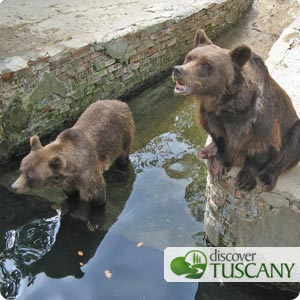
We arrived at the park shortly after it opened to find most of the animals awake and not yet disturbed by all of the visitors. We found the large parking lot empty at that hour and a helpful employee pointed out the best spot to leave the car in to enjoy some shade later on in the day. Upon entering we found a pair of brown bears, the definite stars of the park. There were two bears, housed in a large, half buried cement block, open towards the front. As soon as they see people, they go towards the border of the cement block and wait for you to launch some of the food nuggets you just bought when buying tickets and which they seem to love. They've learned all the tricks: they go towards the person that seems ready to launch a nugget and raise themselves on their haunches and seem to say "I am so cute, you can't deny me some of those nuggets, can you?" One on the right, one of the left, one gets them as they fly while the other gets the ones that land on the ground. They seem to work well together to get all of your precious nuggets and as soon as they realize they're all gone, they back off and wait until the next person shows up to offer some more food.
The lynx was particularly extraordinary to watch, maybe because it is an animal I've always liked. It is really beautiful, a large, slender proud cat. They actually have 3 lynxes in the park, since they've had some of them reproduce. Our excitement is tempered with the reality of seeing a proud lynx walk continuously and nervously back and forth inside a cage, reminding us that she is still a prisoner.
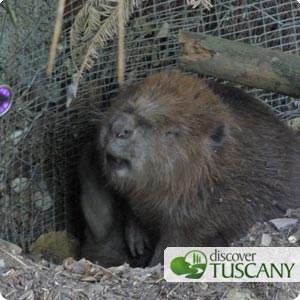
We then come upon the beaver, an animal that rests in its den during the day without knowing it is spied on through a video camera in perfect Big-Brother style. We see its drowsy face as it shifts to get more comfortable on the TV screen, finding its den on one side is visibile for anyone tall enough to see over the fence.
We then come upon the skunk (the European variety, not the white and black American one) and the bloodthirsty weasel. This brings back the farmers' tale: if a weasel gets into the pigeon house, no pigeon survives. To see these small predators you might even think them cute as they run around in their cage, showing their vivacity and agility.
To remain in the area of "terror in the hen-house", we then come upon the blue fox and white fox, whose sly face matches the fame of their species. For now they seem satisfied by the few nuggets we throw at them, but the impression is that they're up to something!
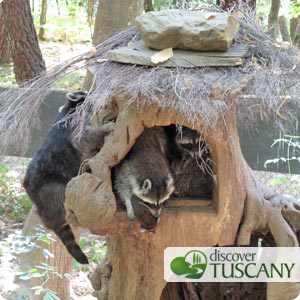
We come upon an entire family of raccoons that steal the show from the other guests at the park: they are all packed into a lair inside a tree trunk. You can see a few small faces in the pack, and once they finally decide to leave their lair it like the magic trick where the magician keeps pulling rabbits from the hat: one, then two, then three and finally four adult raccoons come out, leaving yet two more smaller baby raccoons inside! We watch as the mothers try to get them to move around and get to know the lair, but they are still reluctant to move around. The mother raccoon is forced to pick them from the collar and go through all the tunnels inside their trunk-house together.
Seeing the wolf reminds us of little red-riding hood and other fairy tales we grew up with. The two wolves in the park (the female one was born in the park) however do not match the image presented in these stories and appear as calm, solemn creatures.
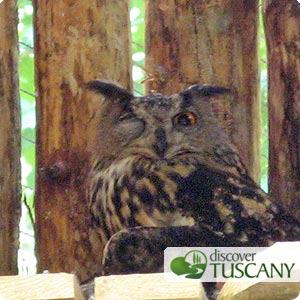
There are numerous bird species, including a few from outside the area such as the golden Chinese pheasant (with beautiful colors) but the ones we consider the most beautiful are the birds of prey. The enormous Eagle-Owl looks at us from its wooden house through an open eye while the other one rests. Probably considers us a nuisance: at this hour he'd prefer to be sleeping! Useless to say, thanks to Harry Potter, that owl is a favorite among the children. It is also impossible to remain impassive in front of the beauty and pride exhibited by the black kite and buzzard, and especially by the tawny eagle.
There are seveal ostriches and emus: we don't have the courage to tell them that they're a little bit out of place amongst the European animals (the first from Africa, the second from Australia). The ostrich is super curious and its large eyes are always seeking something it can peck at.
The large fenced in enclosure that keeps the deer in allows us to admire them from a distance, especially the male one with its large branched-out horns. It is getting pretty hot, so most of them are resting in the shade. In the same enclosure are the mouflon, a species of wild sheep, but the heat seems to have a different effect on them: 5 or 6 males chase and then run into each other head on, the sound of their crashing horns can be heard across the park. We watch with interest this violent brawl while in the corral next door the boar sleeps, seemingly used to its quarrelsome neighbors. Not even two nuggets wake him up!
The buffalo love wallowing in the muddy water to fight back the day's warmth, when they step out they are completly covered in mud and our minds go to the mozzarella: we really hope they are given a shower before they are milked. Even larger than the buffalo is the" Bos Primigenius", a large bull and its mate are truly imposing. They are a sort of ancestor to modern bovines, but these were obtained through "backwards" selection to obtain the original characteristics of the "primitive bovine", particularly its size.
Nearby we found a few Siberian reindeer, to whom we expressed our deep solidarity. One doesn't need to be Dr. Dolittle to understand that they're probably wondering "what am I doing under the sun in 35°C weather ?! "
Decidedly more in their environment are the "little donkeys with blue eyes" from Asinara (an island to the northwest of Sardinia) that while timid go up to visitors for a pat and the hope of something to munch on. The park also hosts a few donkeys from Amiata and a few other types of donkeys and ponies. On a previous visit we had seen a small monkey with its baby, this time they are not present in their cage.
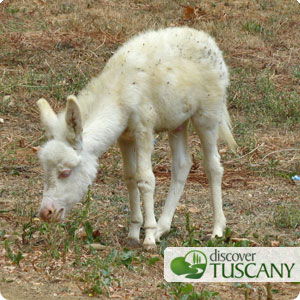
With all of these animals the happiest visitors are without a doubt the children, and most of the visitors at the park are families with kids. The park welcomes families, providing a playground area, a restaurant (open from Easter until fall), a coffee bar and a picnic area. The restaurant offers a fixed price menu at 18 euros as well as offering snacks to be eaten outside.
During our visit we witnessed a small incident: two zoo workers had just placed a young wild cat in its new cage but the electrical wiring that was supposed to keep the cat from climbing up the fence was definitely not working. As soon as the cat was released, it quickly climbed all the way up and almost tasted freedom. The two workers quickly tried to send the cat back into its cage with the use of a long stick but the cat was fast and quickly climbed up the wall again and again until a blow against the cage seemed to make the cat land incorrectly. Probably with a sprained paw, the cat limped and hid in a den inside the cage. We did not have the impression that the cat was mistreated, the personnel were doing their best to keep the cat from escaping and the injury was accidental. But, of course, this incident still makes you stop and think about it.
Soon afterwards, one of the park owners arrived, angry most of all with the electrician that did not check that the system was installed properly. In our brief exchange with her, we received the impression that the woman was passionate about her work, which can have many rewards as well as responsabilities. In this conversation, we learned that the zoo is 100% private, created in 1972 by Roberto Mattoni, a veterinarian. It does not receive public funding of any type and today is managed by Dr. Mattoni's five children.
The Poppi Zoo Park is the only zoo of its kind dedicated to hosting European species, supported by the fact that many of the species reproduce within its boundaries - an indicator that, aside from their lack of freedom, they are generally well taken care of. Having European fauna makes it possible to keep most of the animals in their original habitat (aside from the poor Siberian reindeer). The corrals are almost always made in the best possible way, positioned against the ground and surrounded by green in constrast to the cement cages found in many other zoos we have visited.
When we admire the animals it must still remain clear in our minds that their being there in front of us has a price, which is their freedom. The least we can do is approach them with respect, without scaring or disturbing them, without demanding that they pose for a photograph. If they are the zoo's guests, we are also theirs. When we visit the Poppi Zoo Park with the right type of attitude, our visit will be gratifying and instructional as well as a great way to spend a beautiful day outdoors.






